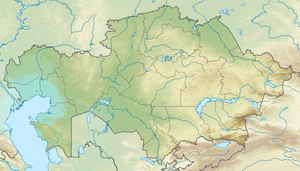 One of the kurgans at Issyk | |
| Coordinates | 43°19′48″N 77°37′07″E / 43.33000°N 77.61861°E |
|---|---|
| Type | Kurgan |
The Issyk kurgan, in south-eastern Kazakhstan, less than 20 km east from the Talgar alluvial fan, near Issyk, is a burial mound discovered in 1969. It has a height of 6 meters (20 ft) and a circumference of 60 meters (200 ft). It is dated to the 4th or 3rd century BC.[1][2] A notable item is a silver cup bearing an inscription. The finds are on display in Astana. It is associated with the Saka peoples.[3]
The burial complex located on the left bank of the Issyk Mountain River, 50 kilometers (31 mi) to the east of the city of Almaty. The unique archaeological complex found by a small group of Soviet scientists led by archaeologist Kemal Akishevich Akishev in 1969. The burial ground consists of 45 large royal mounds with a diameter of 30 to 90 and a height of 4–15 meters (13–49 ft). The Issyk barrow is located in the western half of the burial ground. Its diameter is 60 meters (200 ft), and its height is 6 meters (20 ft).
- ^ Chang, Claudia (2017). Rethinking Prehistoric Central Asia: Shepherds, Farmers, and Nomads. Routledge. p. 72. ISBN 9781351701587.
- ^ Hall 1997
- ^ Kuzmina 2007, p. 103 "The dress of Iranian-speaking Saka and Scythians is easily reconstructed on the basis of... numerous archaeological discoveries from the Ukraine to the Altai, particularly at Issyk in Kazakhstan... at Pazyryk... and Ak-Alakha"

